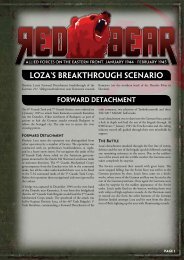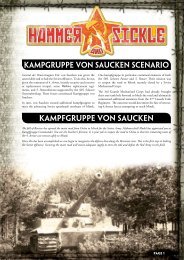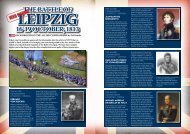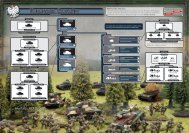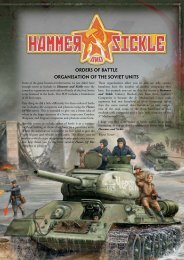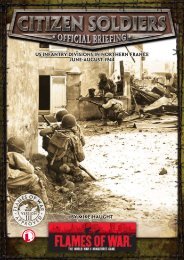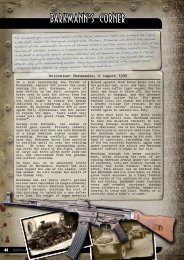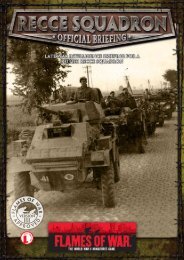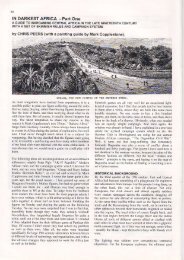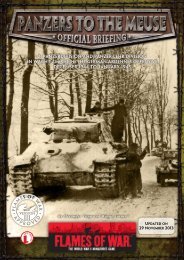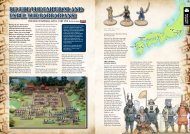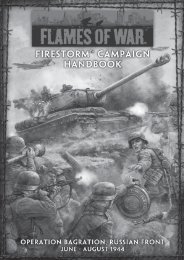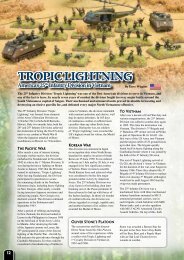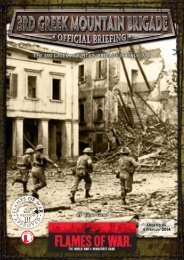INDIAN TRIBES OF THE EASTERN wOODLANDS ... - Flames of War
INDIAN TRIBES OF THE EASTERN wOODLANDS ... - Flames of War
INDIAN TRIBES OF THE EASTERN wOODLANDS ... - Flames of War
You also want an ePaper? Increase the reach of your titles
YUMPU automatically turns print PDFs into web optimized ePapers that Google loves.
wOODLAND LONgHOuSES<br />
Words & pictures by Herb Gundt<br />
This past summer I designed two<br />
Woodland Indian Longhouse<br />
masters for Conquest Miniatures’<br />
500 Nations Range <strong>of</strong> Woodland<br />
Native Americans. Eric Ro<strong>of</strong>,<br />
the proprietor <strong>of</strong> Conquest<br />
Miniatures, talked with me about<br />
doing some conversions to the<br />
resin reproductions <strong>of</strong> the two<br />
longhouses; the point <strong>of</strong> this<br />
exercise being to show gamers<br />
how to create variants for a<br />
Woodland Indian village, using<br />
only two different resin castings.<br />
I decided to make the Large Longhouse<br />
(#500-100) into, what I call, a council<br />
house. I wanted to add a screened<br />
awning to both the front and back<br />
entries. I started the project by cutting<br />
a 1⁄8’’ hardboard base that was large<br />
enough to accommodate the extended<br />
entry areas. I opted to use maple and<br />
oak twigs for most <strong>of</strong> the new model<br />
carpentry, since wood doweling is just<br />
too uniform for this project. I’ve been<br />
collecting maple and oak twigs for<br />
years, mainly when I was out mowing<br />
my lawn, because they are handy to<br />
have around when doing model work.<br />
I always make sure that the twigs are<br />
well dried and always remove the bark<br />
with rough sandpaper. Well, with that<br />
being said we can move on to the actual<br />
conversion work.<br />
I drilled holes into the base for the main<br />
supports and the effigy or scalp pole.<br />
I will discuss the effigy pole in more<br />
detail later. I cut eight pieces <strong>of</strong> twig<br />
1 3⁄4’’ long and glued them into the<br />
previously drilled holes. I next cut four<br />
3 1⁄2’’ long pieces for the horizontal<br />
entry supports and attached them to<br />
the vertical supports. The screening<br />
was made from 1⁄16’’ diameter basket<br />
weaving reed, cut into 1 3⁄8’’ long pieces<br />
and glued to the horizontal supports.<br />
I fabricated the effigy pole from a 4’’<br />
long twig, a 1’’ long reed, two pieces<br />
<strong>of</strong> twine and some thread. I glued the<br />
reed crosswise onto the twig and then<br />
wrapped thread around both pieces to<br />
represent binding. I glued a section <strong>of</strong><br />
twine to the top <strong>of</strong> each side <strong>of</strong> the reed<br />
cross piece, wrapped the twine around<br />
the reed and tied it <strong>of</strong>f with thread. I<br />
used a toothpick to tease out the twine,<br />
coated the twine with white glue and<br />
water and attached the effigy pole to<br />
the base.<br />
I used 1⁄16’’ thick card and tree wrap<br />
to make the ro<strong>of</strong>s. Tree Wrap is used<br />
by gardeners and is a material that<br />
comes on a 3’’ wide roll and resembles<br />
heavy crepe paper. The tree wrap was<br />
cut into random sized pieces and glued<br />
to the card ro<strong>of</strong>. This is a good place to<br />
pause on the description <strong>of</strong> the larger<br />
model and move on to the smaller<br />
longhouse conversion.<br />
I wanted to use the Small Longhouse<br />
(#500-99) to make a Jesuit mission.<br />
Once again I cut a base large enough<br />
to accommodate two covered entries<br />
and, in the case <strong>of</strong> the mission, a bell<br />
on a timber frame.<br />
I made the entry walls, for the Mission,<br />
by gluing six pieces <strong>of</strong> twig together for<br />
each wall. Once the wall sections were<br />
dry, I cut the ro<strong>of</strong> slope <strong>of</strong> the walls with<br />
a dremel tool and then glued the walls to<br />
the model. The mission ro<strong>of</strong>s were made<br />
using the same technique as with the<br />
council house ro<strong>of</strong>s.<br />
The two vertical supports <strong>of</strong> the bell<br />
frame were made from three pieces, with<br />
the outer logs being 1 1⁄4’’ tall and the<br />
center log an eighth <strong>of</strong> an inch shorter.<br />
The two assemblies were then glued to<br />
the base 7⁄8’’ apart from each other. The<br />
horizontal bell support was cut 1 1⁄4’’<br />
long, with a hole drilled in the center<br />
for the bell and another drilled on one<br />
end for a handle. The handle was made<br />
from a piece <strong>of</strong> wire that was cut 3⁄4’’<br />
long and glued to the end <strong>of</strong> the support.<br />
The brass holiday bell was next attached



